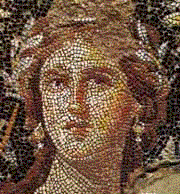Hebrew: Zippori ("bird")
The largest city
in Galilee was located just south of the
road from Ptolemaļs
to Tiberias,
about half-way between the Mediterranean & the sea
of Galilee, perched like a bird on a steep
ridge that rises 300 feet above the valley floor. It was
fortified in the 7th c.
BCE, during the Assyrian occupation of
Israel & served subsequent Babylonian, Persian &
Hellenistic empires as an administrative center for the region.
In 104 BCE
it was taken by Hasmonean forces
led by either Aristobulus
I or Alexander
Jannai. But a generation
later Gabinius,
the Roman governor of Syria gave Sepphoris its own council [Sanhedrin],
making it independent of Jerusalem.
When the Roman Senate made Herod
"king of the Judeans" with authority over Galilee
(39 BCE),
Sepphoris refused to submit to him until subdued in a
bloody siege [Josephus,
War
1.304]. When Herod died (4 BCE),
Judah ben Hezekiah, son of the leader
of the first revolt, plundered the Herodian palace in Sepphoris
& armed the populace. This led Varus,
the new Roman governor of Syria, to burn the city & sell its
inhabitants into slavery.
Herod's
son Antipas
reconstructed Sepphoris as a model Roman city, renaming it
Autocratoris in honor of the emperor Augustus.
For 23 years this was his capitol until he built Tiberias
(19 CE).
Current excavations have not yet determined how much of the
city's eventual 150 acres were developed by Antipas. But this
massive Herodian urban building project, that included a theater
that could seat 15,000 must have had a major impact on the
economy & social life of southern Galilee during the first 2
decades of the 1st c CE,
including residents of surrounding
villages such as Nazareth,
just 3.5 miles to the southeast.
The extent of the Romanization
of Sepphoris was dramatized by the fact that the city refused to
join the great Jewish revolt against Rome (66 CE). Only after
150 CE did it gain religious importance to Jews,
when Judah
ha Nasi moved the rabbinic
Academy there. The Mishna
was published at Sepphoris & it remained a center of
rabbinic teaching clear down to 363 CE when it suffered a major
earthquake.
For further recent information about archaeological & historical evidence, see:
-
Rousseau, John J. &
Rami Arav. Jesus & His World. (Minneapolis: Fortress
Press, 1995) pp. 248-251.
-
Horsley, Richard A. Archaeology,
History & Society in Galilee. (Valley Forge PA: Trinity
Press International, 1996) pp. 43-65.
Other resources
on line:


![]()
![]()
![]()
![]() Perspective
on the World of Jesus
Perspective
on the World of Jesus ![]()